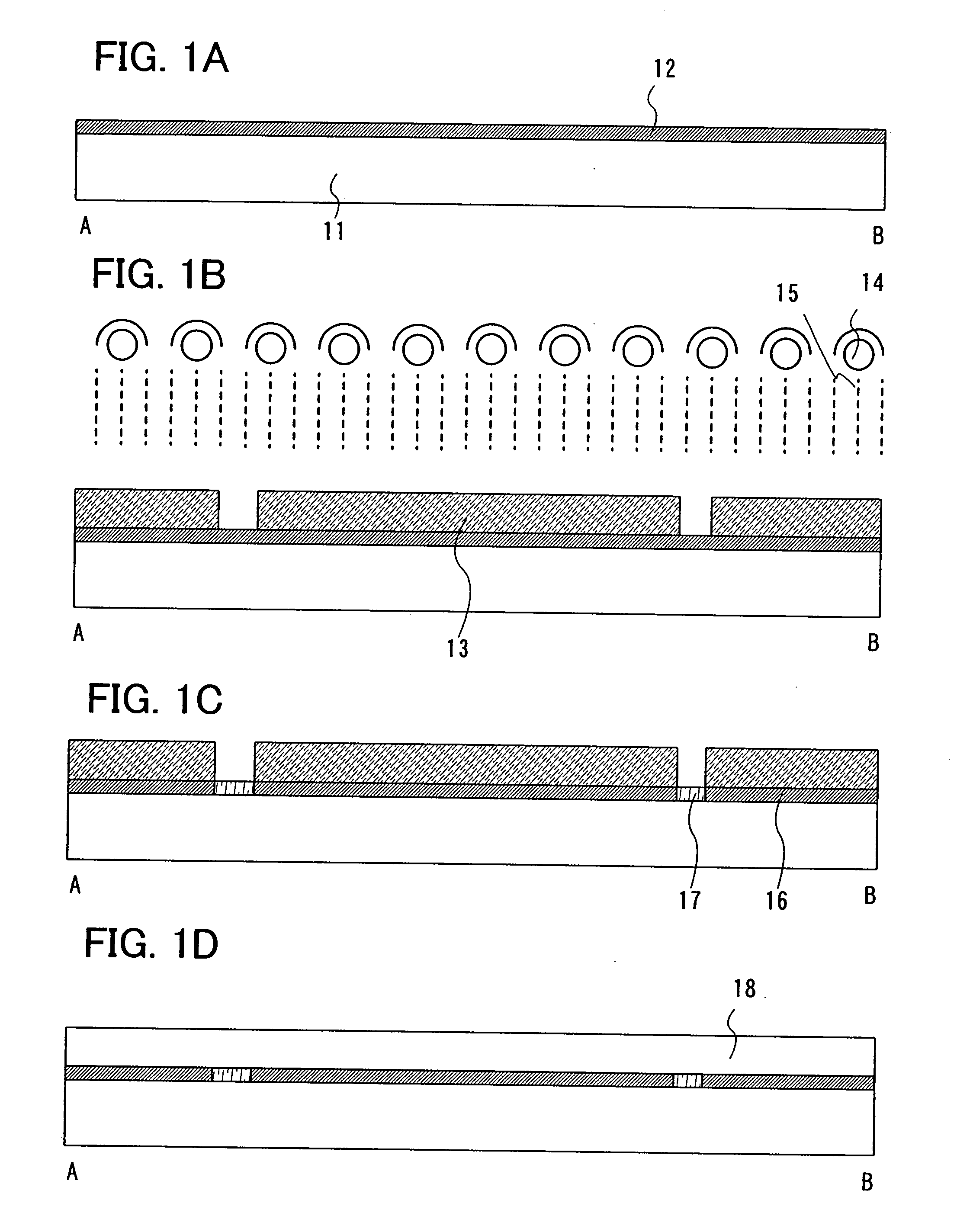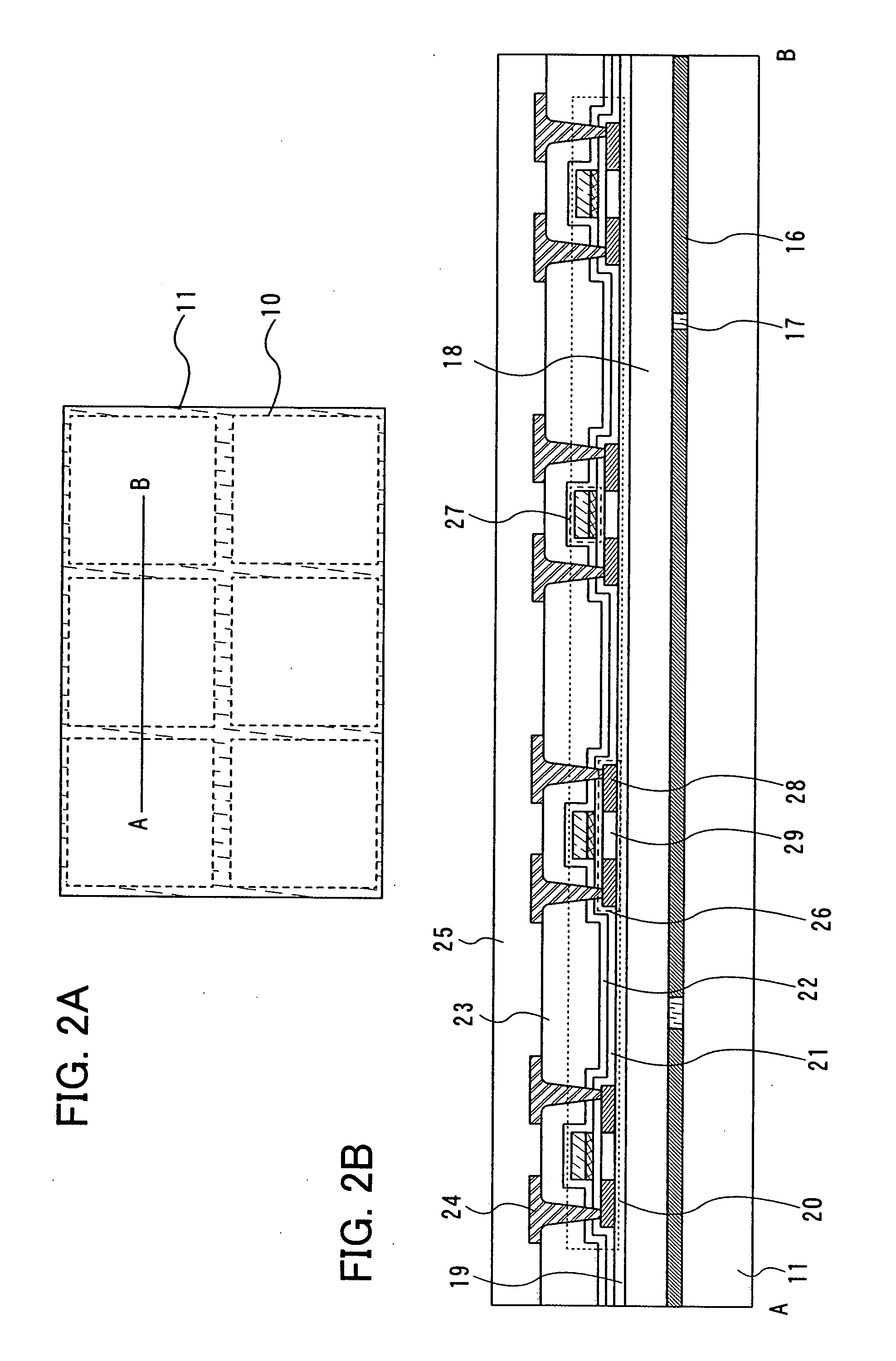Method of manufacturing semiconductor device
- Summary
- Abstract
- Description
- Claims
- Application Information
AI Technical Summary
Benefits of technology
Problems solved by technology
Method used
Image
Examples
embodiment mode 1
[0054]A manufacturing method of a semiconductor device of the present invention is described with reference to FIGS. 1A to 4B. A case in which six semiconductor devices are manufactured over a substrate is described below. In each of FIGS. 2A, 3A, and 4A, a region in which one semiconductor device is provided corresponds to a region 10 surrounded by a dotted line. FIGS. 2B, 3B, and 4B correspond to cross-sectional views taken along lines A-B in FIGS. 2A, 3A, and 4A, respectively. In addition, cross-sectional views in FIGS. 1A to 1D correspond to cross-sectional views taken along lines A-B in FIGS. 2A, 3A, and 4A.
[0055]First, a liquid repellent film 12 is formed over a substrate 11 as a liquid repellent self-assembled monolayer (see FIG. 1A). The liquid repellent film 12 may be formed using a silane coupling agent having a fluoroalkyl group (fluoroalkylsilane, hereinafter referred to as FAS). The substrate which is heated and FAS are confined so as to form a FAS self-assembled monola...
embodiment mode 2
[0080]In a method of manufacturing a semiconductor device of the present invention, FAS can be decomposed by back surface light exposure. The use of back surface light exposure can omit a removing step of a mask. In this embodiment mode, a substrate with a light-transmitting property (hereinafter, referred to as a light-transmitting substrate) is used so that back surface light exposure can be conducted. A substrate which transmits light that is used in the back surface light exposure is used as the light-transmitting substrate. A description is made below with reference to FIGS. 2A to 5D. Note that the same layers are denoted by the same reference numerals in different embodiment modes.
[0081]First, the mask which blocks light is formed over a light-transmitting substrate 11a. As the light-transmitting substrate 11a, a quartz substrate may be used, for example. A material for the mask 13 is not specifically limited and is acceptable as long as the material can block the light 15 whi...
embodiment mode 3
[0090]In a method of manufacturing a semiconductor device of the present invention, FAS can be decomposed by back surface light exposure as described in Embodiment Mode 2. Note that, since it is necessary to use light which is in a wavelength range with which the light can pass through a light-transmitting substrate and a liquid repellent film can be decomposed, there is a possibility that the light in a wavelength range needed for decomposition of the liquid repellent film does not reach the liquid repellent film, depending on a combination of the light-transmitting substrate and the liquid repellent film. A case in which a glass substrate is used as the light-transmitting substrate and FAS is used for the liquid repellent film can be given as an example of such a situation. A glass substrate does not transmit light in a wavelength range of less than or equal to 300 nm, whereas FAS needs light in a wavelength of less than or equal to 200 nm to be decomposed; therefore, a liquid rep...
PUM
 Login to View More
Login to View More Abstract
Description
Claims
Application Information
 Login to View More
Login to View More - R&D Engineer
- R&D Manager
- IP Professional
- Industry Leading Data Capabilities
- Powerful AI technology
- Patent DNA Extraction
Browse by: Latest US Patents, China's latest patents, Technical Efficacy Thesaurus, Application Domain, Technology Topic, Popular Technical Reports.
© 2024 PatSnap. All rights reserved.Legal|Privacy policy|Modern Slavery Act Transparency Statement|Sitemap|About US| Contact US: help@patsnap.com










